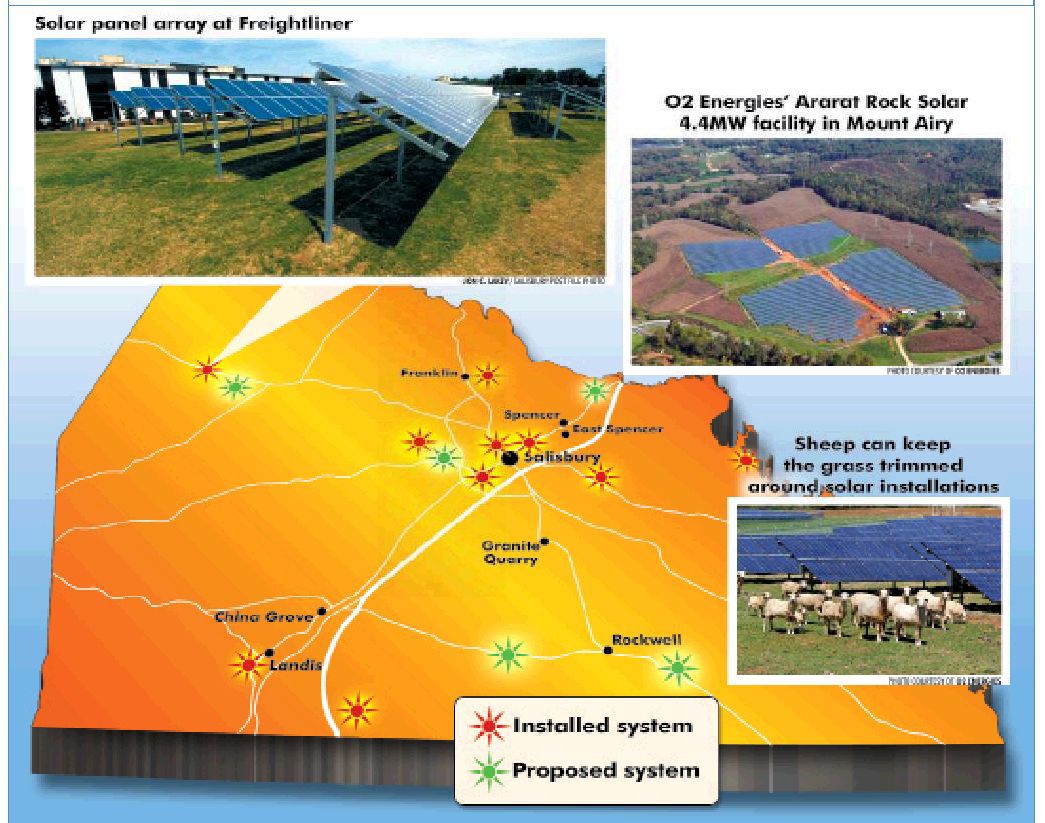Rowan’s future in solar farms looks sunny
Published 12:00 am Saturday, May 24, 2014
SALISBURY — The hottest new harvest in Rowan County may not come from a fruit, vegetable or grain but from the sun itself.
Five proposed solar farms have earned approval from Rowan County commissioners and Salisbury City Council, representing a potential total investment of roughly $50 million and hundreds of construction jobs to build the facilities.
In a county with zero solar farms, interest in locating the ground-mounted, utility grade renewable energy projects here has flared up during the past 13 months. None of proposed farms — most about 40 acres in size — is under construction yet, but at least one company plans to start work this fall.
“This is an overnight success story 40 years in the making,” said Robert Van Geons, executive director for RowanWorks Economic Development.
Several organizations, including Beaver Brothers and Catawba College’s Center for the Environment, recognized the potential for solar years ago and have watched the technology grow into a consistent staple of the overall energy portfolio that now shows positive financial results, Van Geons said.
More farms could be on the horizon. RowanWorks has identified dozens of potential sites for commercial solar installations. A good site is slightly off the beaten path with no water or sewer service but relatively easy access to the power grid.
Land for a solar farm, usually between 18 and 60 acres, doesn’t have to perk for septic or have excellent soil for growing crops. Rowan is well-situated for solar farms with its proximity to major markets for construction, services and labor, as well as accessible tracts of land that are not suitable for more intense development.
“We are targeting properties where this may be one of the better uses,” Van Geons said.
He said Rowan is lucky to have Duke Energy’s robust distribution network throughout the county, as well as a number of progressively minded property owners.
Leasing land to a solar farm is lucrative. Land owners can command between $300 and $700 an acre and sign leases for a decade or longer.
“This can provide a property owner with a very stable source of revenue for a very lengthy period of time,” Van Geons said.
Some property owners pursue solar solely for financial benefit. Others want to help lessen the demand on foreign oil and fossil fuels by contributing to the amount of renewable energy feeding into the grid.
When a solar farm has harvested its last ray of sunshine, usually after about 30 years, the developer disassembles the panels and racking system and hauls them away. The land is basically in the original condition, other than post holes.
“There are few other uses I can think of especially in the energy production sector that can be completely removed with no impact to the land,” Van Geons said.
Proposed Rowan solar farms are:
• O2 Energies in the 3400 block of Earnhardt Road, Rockwell
• Sunlight Partners in the 400 block of St. Peters Church Road, Gold Hill
• Sunlight Partners in the 1100 Block of Cruise Road, Salisbury
• Argand Energy at 1200 Redmon Road, Cleveland
• Strata Solar near intersection of N.C. 150 and Sherrills Ford Road, Salisbury
Solar isn’t new to Rowan County, which already boasts numerous ground-mounted and rooftop photovoltaic systems valued at more than $9.5 million, according to the N.C. Sustainable Energy Association.
Food Lion has the biggest project in Rowan, a 1.3-megawatt system on top of the distribution center on Harrison Road. Next is Duke Energy’s mini-farm in front of Daimler’s Freightliner truck manufacturing plant in Cleveland, a 359-kilowatt ground-mounted system.
Several smaller commercial and residential systems follow, including a rooftop array on Wallace and Graham’s law office in Salisbury. By comparison, solar investment in Iredell and Stanly counties has not reached the $1 million threshold. Davie County has solar valued at $20.6 million, and Cabarrus County comes in at $23.3 million.
Duke Energy’s massive, 16-megawatt farm in Davidson County brings the value of solar there to $130.8 million.
With $9.5 million already installed and a potential $50 million more in the pipeline, Rowan’s future in solar looks sunny, said Betsy McCorkle, director of Government Affairs for the N.C. Sustainable Energy Association. Cities and counties that embrace solar projects and streamline their permitting path recognize the boost to the local tax base that solar farms represent without the burden of providing services like water, sewer and schools, she said.
The uptick in solar farm interest is going on around the state, thanks to North Carolina’s aggressive renewable energy tax credit and the improving economy. North Carolina is the only state in the Southeast offering a 35 percent tax credit against the cost of the equipment, McCorkle said.
The personal credit for renewable energy investment is capped at $10,500, and the commercial credit maximum is $2.5 million. The credit works, McCorkle said. Since 2007, North Carolina has seen $2.1 billion invested in renewable energy, including solar, she said.
For every $1 in incentives, $1.93 goes back to state and local governments in sales tax, property tax and income tax revenue, McCorkle said.
Solar and agriculture can go hand in hand, she said, with farmers leasing a portion of their acreage for a solar farm and using the proceeds to help support the rest of their operation.
Land owners who lease to solar farms may end up paying more in property taxes. Land that has qualified for special tax status as a farm or pasture is valued at about 10 percent of market value, and the owner may lose that designation switching from raising crops or animals to capturing the sun’s energy.
One company, O2 Energies, might be able to keep the tax status in Rowan County because of its unusual lawn maintenance crews. T&D Farms in China Grove plans to raise 150 sheep amongst the 20,000 panels at O2’s proposed $10 million, 4.25-megawatt DC solar farm near Rockwell.
While using livestock for lawn maintenance may represent a tax advantage, O2 project developer Logan Stephens said the company’s main motivation is sustainability.
“We are trying to keep our sites in agriculture for good environmental stewardship,” said Stephens, who pointed out that O2 is leasing land in Rowan, so any tax benefit would go to the property owner.
The development of solar farms was slowed by the recession, but the industry came out of the downturn stronger, Van Geons said.
“Since that time, while it was rough and tumble, those developers in solar have found ways for make their projects work in a less robust economy,” he said.
An internal cultural shift among utilities like Duke Energy toward renewables has given solar farms a major boost. External pressure from lawmakers and regulators also has motivated power providers to diversify and experiment with renewable energy options.
On the corporate side, companies are gradually moving to the triple bottom line of energy costs, efficiency and their environmental footprint, Van Geons said. Solar can help a company cut expenses while reducing its impact on the environment, he said.
The more solar farms Rowan can boast, the more likely the county will earn a second look from companies searching for industrial sites.
“There are number of Fortune 100 companies that very much weigh access to renewable sources of energy as part of their facility location decision,” Van Geons said. “Solar farms and the Center for the Environment, those types of things represent very positively for our community.”
Solar farms have a secondary economic impact on a community, including increased interest from other industries that want to locate near the facilities, Van Geons said.
“We are seeing interest from manufacturers and integrators,” he said.
Manufacturers of LED lighting, advanced battery systems and hydrogen fuel cell are interested in locating near solar and other renewable energies.
“This region’s growth in energy-related industries is nearly unparalleled in North Carolina compared to other states,” Van Geons said.
Workers who gain experience installing a solar farm and earn certifications in the industry can easily transfer those skills to other advanced manufacturing jobs, he said.
Local governments that want to recruit solar farms should streamline the permitting process as much as possible, McCorkle said. Her organization provides a draft ordinance to any city council or county commission interested in simplifying the process to help lure developers.
“It’s a big state, and developers have a lot of options of where to locate their farms, and they want to be in places where they feel welcome,” she said.
Developers anticipate some opposition in areas of the state where solar farms are a new concept, she said. Neighbors complained to Rowan commissioners in February about Argand Energy Solutions’ plans to put a 5-megawatt system in the 1300 block of Redmon Road, saying solar farms should be built only in industrial areas.
A woman who lives next to the planned Strata Solar project on Sherrills Ford Road told City Council earlier this month she worried about the solar farm making her sick and causing environmental contamination. An attorney for Strata, who for the first time in City Council history cross-examined a speaker, said the farm will contain no hazardous substances, create no pollution and use different technology than the examples cited by the neighbor.
“I think it’s an education process. People absolutely have the right to be involved with what’s going on around them and have their voices heard, but ultimately, these projects are very quiet with no glare or odor,” McCorkle said.
Most developers will gladly add a buffer of trees and bushes to help make a solar farm more palatable to concerned neighbors, she said. Strata agreed to plant a 600-foot evergreen buffer to block the panels from the concerned woman’s property.
Salisbury attorney Randy Reamer and his wife Marcia Reamer hope to lease part of their 200-acre horse farm to Strata, which approached the family. Randy Reamer would not disclose the terms of their lease but said a solar farm is “much more lucrative than standing horses in a pasture.”
“We have our fingers crossed that our project will be built,” he said.
Reamer said he was encouraged to learn that the sunlight harvested by solar panels on his farm would power about 700 houses and businesses each year in Salisbury. The local government approval process took longer than expected and put the project slightly behind schedule, he said.
A member of the Salisbury Planning Board, Reamer said he knows developers have to jump through hoops to get anything approved. But some of the regulations seemed excessive, he said.
To meet the city’s landscape ordinance, which requires 30 percent of the land to be covered with trees, Strata had to lease additional land to dedicate to trees, Reamer said.
The company “has accommodated local officials and neighbors at every turn,” he said.
With local government approval in place, developers of the five proposed solar farms are now likely working on financial arrangements with investors and ironing out agreements with Duke Energy. From there, they will need to sign contracts with contractors and engineers to design and build the systems and obtain materials and financing.
“These projects are very complicated to put together in terms of structure and timing,” Stephens said. “We have been working diligently.”
Stephens said the chances of the O2 project moving ahead are good.
“We have had a very positive experience working with Rowan County and getting zoning approval,” he said. “We are thankful that county leadership is supportive of our efforts.”
Contact reporter Emily Ford at 704-797-4264.





